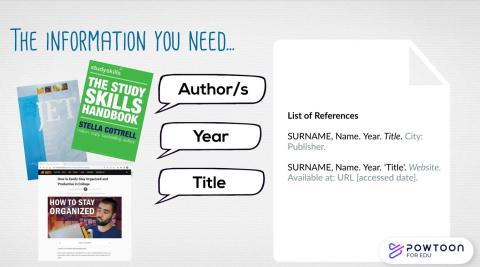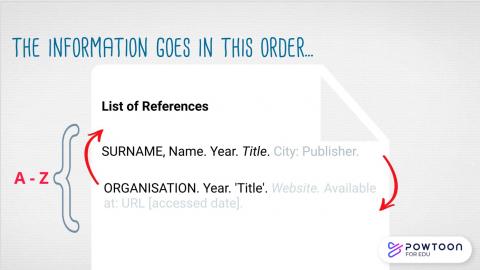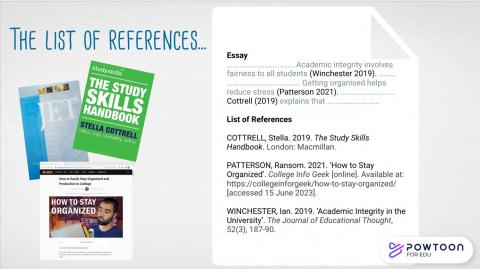How to create a list of references
Test Yourself: How to create a List of References
Transcript:
How to create a List of References or Bibliography using Falmouth University Harvard style.
Brought to you by ASK Academic Skills.
The information you need for a list of references:

When you find something in your reading and research that you want to use in your own work, make a note of
-
the author or creator,
-
the year it was published
-
and the title of the work
Then depending on what kind of source it is - a book, a journal article, or a website, for example - you will need specific details for that type of source as well.
At the end of your work, each reference used will go in a List of References or Bibliography.
The information goes in this order:

Each reference starts with:
- the author’s surname – written all in capital letters,
- the author’s first name and/or initial,
- the year it was published or created and
- the title of the work, in that order.
If the author is an organisation rather than a person, write the name of the organisation all in capital letters.
This List of References is organised in alphabetical order by authors’ surname which is written all in capital letters.
Citations point to their corresponding references in the reference list:

When you refer to a source in your writing or presentation, include an in-text citation with the author and year, and make sure that this points to its corresponding full reference in the alphabetical List of References or bibliography at the end of your writing.
The Guide to Harvard Referencing at Falmouth University
The Guide to Harvard Referencing at Falmouth University provides further explanation, and examples, of how to reference books and other types of sources. For example, articles, websites, TV programmes, films, digital games, exhibitions, performances and so on.
DOWNLOAD the Referencing Guide
The guide explains how to cite these sources and how to put them into a List of References. It also explains what to do if information is missing and if there is more than one author, for example.
See the StudyHub for more videos
See the StudyHub to learn why and how to reference and cite correctly.
Brought to you by ASK Academic Skills
This video was brought to you by ASK Academic Skills.
If you have any questions about referencing or other study skills, please find us on the StudyHub.